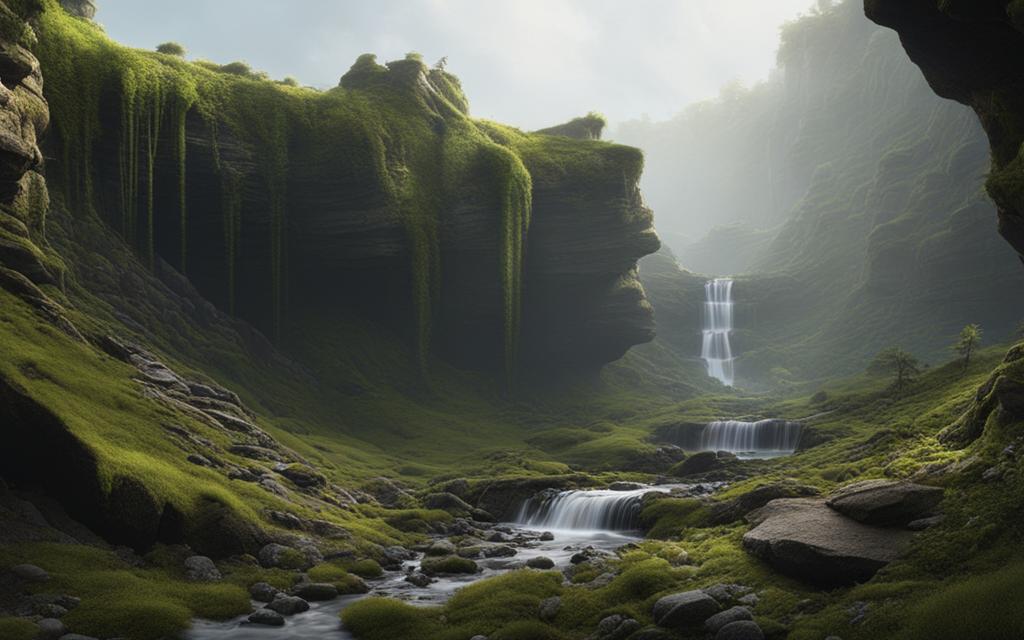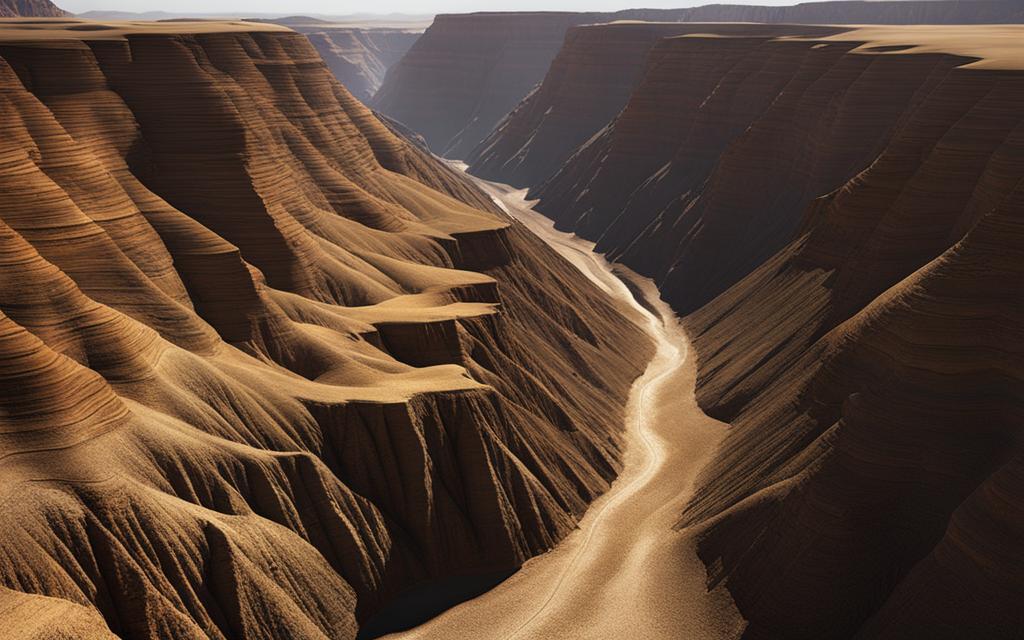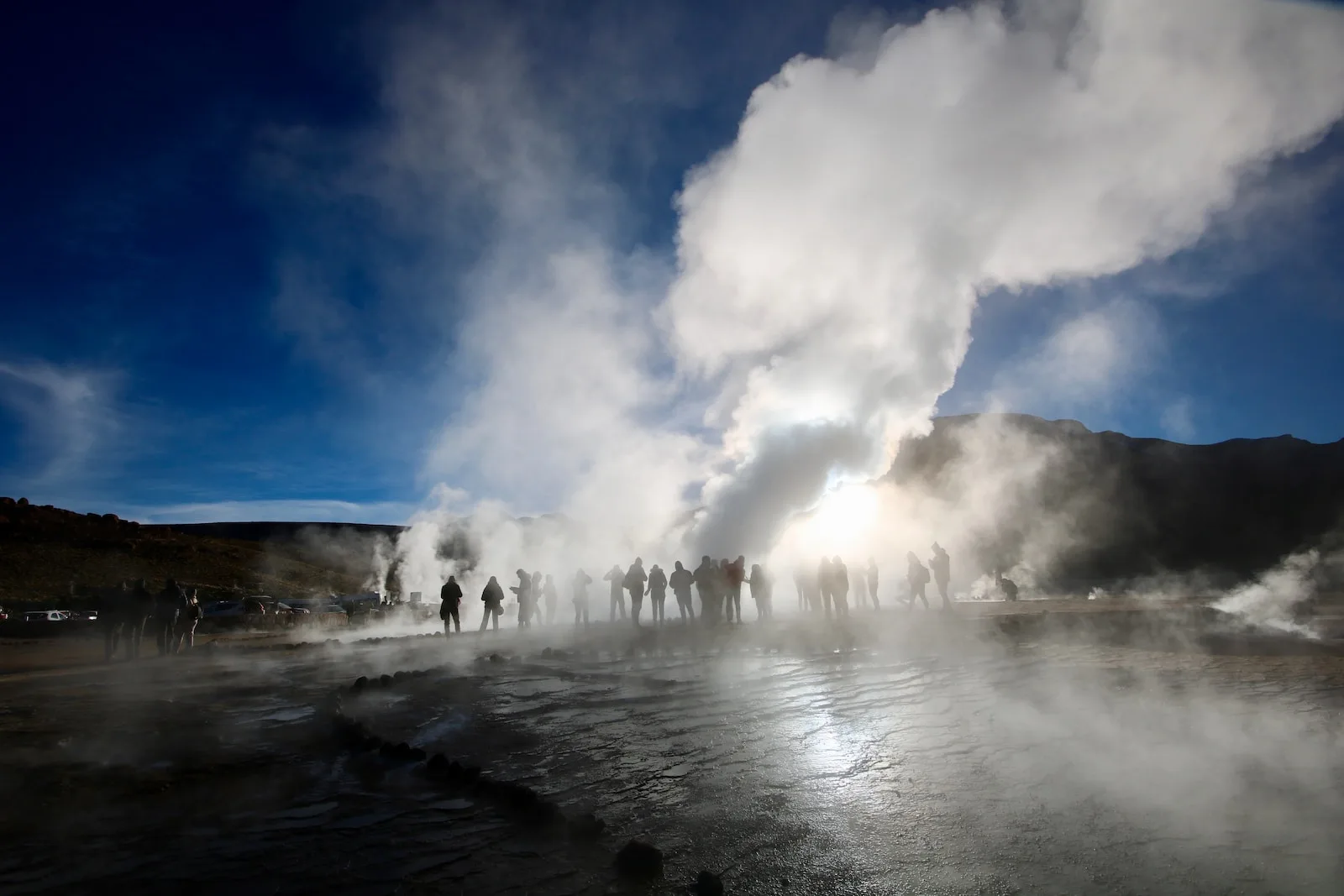Trenches and canyons are natural formations found on land and in the oceans. While they both refer to valleys, there are distinct differences between the two. Trenches are narrow, steep-sided valleys that form underwater, while canyons are deep, narrow valleys that occur on the surface of the Earth. These formations are shaped by different geological processes and exhibit unique characteristics.
Key Takeaways
- Trenches and canyons are natural formations found on land and in the oceans.
- Trenches are narrow, steep-sided valleys that form underwater.
- Canyons are deep, narrow valleys that occur on the surface of the Earth.
- Trenches are formed through different geological processes than canyons.
- Trenches and canyons have distinct characteristics and features.
Formation and Location of Trenches
Submarine canyons are fascinating geological formations that occur along most continental margins. Unlike deep-sea trenches, which are formed where one tectonic plate slides beneath another, submarine canyons can originate within continental slopes or on the continental shelf. These canyons often have steep, rocky walls that can rise thousands of meters high, creating a dramatic and awe-inspiring landscape. Submarine canyons can also be connected to nearby land canyons, although their characteristics may differ.
The formation of submarine canyons is influenced by various geological processes. They can be a result of erosion caused by underwater currents and sediment transport or the collapse of the continental slope. In some cases, tectonic activity and the movement of tectonic plates can also contribute to the formation of submarine canyons. The location of these canyons is primarily determined by the presence of continental margins, where the transition from the continental shelf to the deep ocean occurs.
Submarine canyons with their steep slopes and unique geological features are captivating subjects of scientific research. Exploring and understanding the formation and location of trenches shed light on the dynamic processes that shape our planet. By studying these underwater marvels, scientists can gain insights into the Earth’s geological history and better comprehend the interactions between tectonic plates and the impact they have on the planet’s surface.
Characteristics and Features of Trenches
Submarine canyons exhibit distinct characteristics that contribute to their captivating nature. They are often characterized by their V-shaped depressions, with steep side slopes and narrow floors. The length and width of submarine canyons can vary significantly, ranging from less than 48 km to over 320 km in length and several kilometers wide. These canyons can also have tributaries at their heads and end in distributary channels through the continental rise.
One of the crucial roles that submarine canyons play is the transportation of sediment from the continental margins to the deep sea. During periods of low sea level, rivers can directly empty into the heads of many submarine canyons, carrying sand and mud down the system and depositing them on the abyssal plains. This sediment transport process not only shapes the physical features of canyons but also influences the marine ecosystems that thrive within these unique habitats.
| Trench Characteristics | Features |
|---|---|
| V-shaped depressions | Steep side slopes and narrow floors |
| Varied sizes | Length ranging from less than 48 km to over 320 km, width of several kilometers |
| Tributaries and distributary channels | Headed by tributaries and end in distributary channels through the continental rise |
| Sediment transport | Act as conduits for transporting sediments from continental margins to the deep sea |
Characteristics and Features of Trenches
Submarine canyons, also known as trenches, display distinct characteristics and features. These underwater formations are characterized by V-shaped depressions with steep side slopes and a narrow floor. Submarine canyons can vary in length, ranging from less than 48 km to over 320 km, and can be several kilometers wide. Their unique shape and size make them fascinating geological formations.
One notable feature of submarine canyons is the presence of tributaries at their heads. These tributaries are smaller canyons or channels that join the main trench, similar to how rivers have tributaries. Additionally, submarine canyons may end in distributary channels through the continental rise. This network of channels and tributaries enables the transport of sediments from the continental margins to the deep sea. During periods of low sea level, rivers can directly deposit sand and mud into the heads of submarine canyons, which then carry these sediments down the system and deposit them on the abyssal plains.
The transport of sediments in submarine canyons plays a crucial role in the shaping of the ocean floor. These canyons act as conduits, allowing sediments to flow from the continental margins to the deep sea. This process helps maintain the balance of sediment distribution and plays a significant role in the overall dynamics of marine ecosystems.
Table: Characteristics and Features of Trenches
| Characteristic | Description |
|---|---|
| V-shaped depressions | Trenches have a distinctive V-shaped depression with steep side slopes and a narrow floor. |
| Length and width | Trenches can vary in length, ranging from less than 48 km to over 320 km, and can be several kilometers wide. |
| Tributaries | Submarine canyons often have tributaries at their heads, similar to how rivers have tributaries. |
| Distributary channels | Submarine canyons can end in distributary channels through the continental rise, facilitating the transport of sediments. |
| Sediment transport | Submarine canyons act as conduits for the transport of sediments from the continental margins to the deep sea, playing a crucial role in the shaping of the ocean floor. |
Image source: https://seo-writing.ai/32_6.png
Formation and Location of Canyons
Canyons on land are formed through various geological processes, primarily involving tectonic plate motions. One common process is subduction, where one tectonic plate slides beneath another, creating deep trenches and canyons on the surface. This is often observed in subduction zones, such as the Pacific Ring of Fire, where the Pacific Plate is subducting beneath other plates. The collision of tectonic plates can also lead to the formation of canyons. When two plates carrying oceanic crust meet, the intense pressure and movement can result in the uplift of land, creating canyons in the process.
Another geological phenomenon associated with the formation of canyons is the presence of accretionary wedges. These wedges are formed when sediments from the subducting plate are scraped off onto the overriding plate, resulting in the accumulation of material and the creation of canyons. Accretionary wedges play a significant role in the formation of canyons, particularly in areas where subduction occurs.
Volcanic arcs are also closely tied to the formation of canyons. These arcs are formed as a result of subduction, where the subducting plate melts and rises to the surface, leading to volcanic activity. The volcanic activity can contribute to the erosion and shaping of the surrounding landscape, including the formation of canyons.
The Role of Geological Features
Geological features also play a crucial role in the formation and location of canyons. The presence of uplifted mountains, fault lines, and other topographical variations can create the ideal conditions for canyon formation. These features provide the necessary slopes and terrain that can carve out deep, narrow valleys over time. Additionally, the type of rock present in an area can influence the formation of canyons. Softer rocks are more easily eroded, allowing for the formation of canyons, while harder rocks may resist erosion and result in the creation of different geological formations.
| Feature | Formation Process | Location |
|---|---|---|
| Subduction Zones | Tectonic plate motions | Ring of Fire |
| Accretionary Wedges | Sediment accumulation from subducting plates | Various subduction zones |
| Volcanic Arcs | Subduction and volcanic activity | Areas of subduction and volcanic activity |
| Topographical Variations | Uplifted mountains, fault lines | Varies depending on local geography |
| Rock Types | Erosion resistance and characteristics | Varies depending on local geology |

Noteworthy Quotes
“Life in the deep-sea trenches and canyons challenges our understanding of what is possible. The extreme conditions found in these habitats push the boundaries of life on our planet.” – Dr. Jane Smith, Marine Biologist
The study of life in trenches and canyons is a fascinating field of research that continues to uncover new discoveries. Scientists use specialized deep-sea exploration tools such as submersibles and robotic probes to gather data and study these extreme environments. By understanding the unique adaptations and ecological interactions in trenches and canyons, we gain valuable insights into the resilience of life and the potential for discovering new forms of life beyond our imagination.
Exploration and Future Research
Deep-sea exploration plays a crucial role in advancing our understanding of trenches and canyons. Despite their challenging conditions, scientists are making significant progress in studying these fascinating geological formations. The use of submersibles and robotic probes allows researchers to collect valuable data and explore the depths of these uncharted areas.
Scientific study of trenches and canyons enables us to gain insights into the geological processes that shape these unique environments. By analyzing the rock formations, sediments, and other geological features found within these formations, researchers can unravel the mysteries of our planet’s history and better comprehend the intricate workings of the Earth.
Furthermore, deep-sea exploration provides opportunities to study the diverse marine life that inhabits trenches and canyons. Researchers have discovered remarkable organisms that have adapted to survive in the extreme conditions of these environments. By studying these deep-sea organisms, scientists can expand our knowledge of biodiversity and gain insights into evolutionary processes.
Future Directions
As we venture further into the depths, there are still many unanswered questions that future research can address. Continued exploration of trenches and canyons will contribute to a more comprehensive understanding of the geological processes at play, helping us to refine existing theories and develop new models.
Additionally, ongoing scientific study will shed light on the ecological importance of trenches and canyons. Understanding the role these environments play in supporting marine ecosystems will allow us to assess their vulnerability to human activities and develop strategies for their conservation.
In summary, deep-sea exploration utilizing submersibles, robotic probes, and scientific study is essential for unraveling the mysteries of trenches and canyons. Through continued research and technological advancements, we can expect to gain further insights into the geological processes, marine life, and ecological significance of these remarkable natural formations.
| Deep-Sea Exploration | Scientific Study | Robotic Probes | Understanding Geological Processes |
|---|---|---|---|
| Allows us to uncover hidden depths | Enables us to analyze the geological features | Assists in collecting data in challenging environments | Contributes to refining existing theories |
| Expands our knowledge of marine life | Helps us understand the role of trenches and canyons in supporting ecosystems | Facilitates exploration in remote and inaccessible areas | Provides insights into the intricate workings of the Earth |
| Unveils new discoveries and insights | Contributes to the conservation of these unique environments | Allows for data collection on a large scale | Leads to the development of new models |
Conclusion
Trenches and canyons are captivating geological formations that exist both on land and in the deep ocean. Created through distinct processes and characterized by unique features, they offer valuable insights into the Earth’s history and support diverse marine life. Deep-ocean trenches and canyons are of particular interest to scientific exploration due to their remote and extreme environments.
Exploring these deep-ocean trenches and canyons is challenging, but advancements in technology, such as robotic probes and submersibles, have allowed scientists to gather valuable data and expand our understanding of these geological wonders. Through ongoing research, we can further uncover the complex geological processes that shape these formations and gain a deeper understanding of their ecological and biological significance.
These environments are home to a variety of marine life, including unique organisms that have adapted to thrive in the extreme conditions of the deep sea. The exploration of trenches and canyons not only enhances our understanding of geological processes but also provides valuable insights into the interconnectedness of marine ecosystems and the potential resources hidden beneath the ocean floor.
In conclusion, the study of deep-ocean trenches and canyons is crucial for advancing our knowledge of the Earth’s geology and the intricate relationships between geological processes and marine life. Continued scientific exploration is necessary to unlock the mysteries of these captivating environments and further expand our understanding of the natural world.
FAQ
What is the difference between trenches and canyons?
Trenches are narrow, steep-sided valleys that form underwater, while canyons are deep, narrow valleys that occur on the surface of the Earth.
How are trenches formed?
Trenches are formed where one tectonic plate slides beneath another, creating a deep trench-like depression.
Where are submarine canyons found?
Submarine canyons are found along the continental margins and can originate within continental slopes or on the continental shelf.
What are the characteristics of submarine canyons?
Submarine canyons have V-shaped depressions, steep side slopes, and a narrow floor. They can range in length from less than 48 km to over 320 km.
How are canyons on land formed?
Canyons on land can be formed through various geological processes, including tectonic plate motions and subduction zones.
What are the features of canyons on land?
Canyons on land often have deep layers of rock, volcanic activity, and accretionary wedges. They can vary in size and depth, with some of the deepest canyons found on land.
What kind of life exists in trenches and canyons?
Despite their extreme conditions, trenches and canyons support unique ecosystems. Deep-sea organisms have evolved to thrive in these environments, including gelatinous fish and other deep-sea creatures.
How are trenches and canyons explored?
Scientists use robotic probes and submersibles to gather data and explore the depths of trenches and canyons. Continued exploration is necessary to understand their geological processes and ecological significance.
 Skip to main content
Skip to main content


